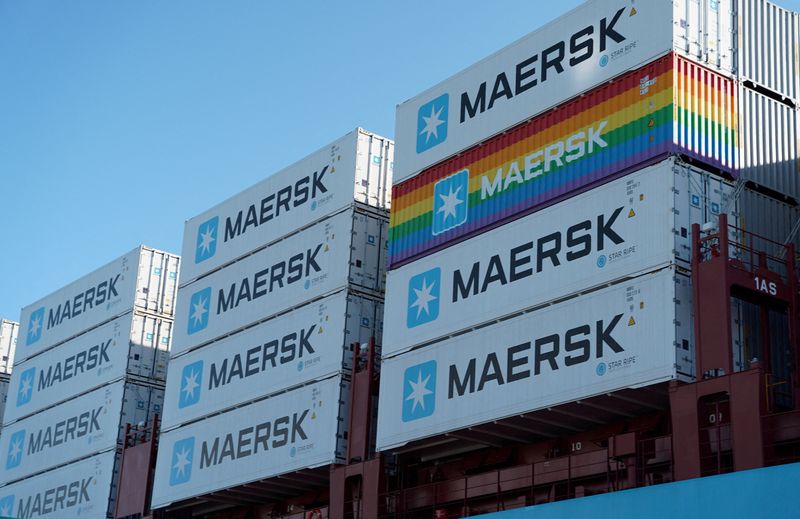By Jesus Calero and Louis van Boxel-Woolf
(Reuters) - European shipping firms Maersk and Hapag-Lloyd are unlikely to get a big boost from soaring freight rates due to the Red Sea crisis in the first quarter, reinforcing worries about overcapacity in the long run.
Spot freight rates tripled to almost $3,500 a container after vessels began avoiding the Red Sea due to attacks by Houthi militants, the Freightos Baltic Index showed. Since then, they have eased back to about $2,400.
That compares to the pandemic peak of $13,559, at a time when shippers ordered new vessels in a move that later caused overcapacity, according to Stifel analyst Marc Zeck.
Diverting ships around Africa uses that up, but the question is how much and for how long.
"Everybody believes that the Red Sea crisis will end at some point. Once the crisis ends, vessels will go through the Suez Canal and then we will have overcapacity again," Zeck said.
Echoing this, Bernstein analyst Alexander Irving said he expects a 15% fleet expansion across 2024 and 2025, outstripping demand.
Maersk CEO Vincent Clerc told investors in February that about twice as many ships were coming to market than what was required to reroute shipments.
Hapag-Lloyd and Maersk have guided very widely for 2024, citing the uncertain impact of the Red Sea crisis on rates.
Hapag-Lloyd expects earnings before interest and tax to be between minus $1.1 billion and $1.1 billion, after $2.5 billion in 2023. Maersk has forecast annual EBIT of minus $5 billion to $0, versus $3.9 billion profit last year.
In February, Clerc said higher rates could assist Maersk in reaching a break-even point during the first quarter.
However, achieving overall break-even for the year might be challenging, Zeck said, as the Red Sea crisis is likely to have its strongest impact in the first quarter before fading.
"At some point, you need to have a positive number on the EBIT side to make up for the negative numbers that are expected to come. I don't know how they will accomplish that," Zeck said.
Maersk's shares closed down almost 15% on the day Clerc made his bearish comments, and have fallen a quarter from their post crisis peak in early January.
They are more than 10% down on Dec. 15, when Maersk first paused voyages through the Red Sea.
The January-March quarter is the first spent entirely during the crisis and hence the first opportunity to see what it means for the shippers and their year ahead.

Maersk reports first-quarter results on Thursday, followed by Hapag-Lloyd on May 15.
($1 = 0.9381 euros) (This story has been corrected to say pandemic peak freight price was $13,559, not $11,137, in paragraph 3)